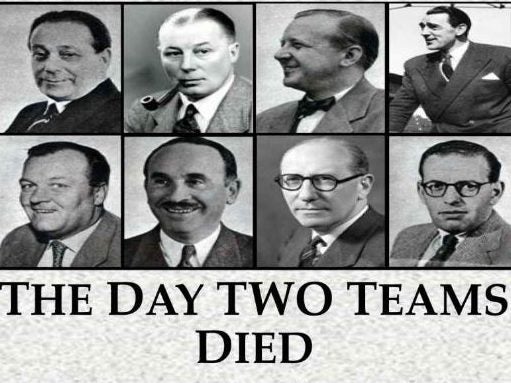
As football has remembered in recent days, 60 years ago, on February 6, 1958, the British European Airways Elizabethan class aircraft carrying the Manchester United team home from Belgrade crashed on its third attempt to take off from the slush-covered runway of Munich-Riem airport.
Twenty of the 44 people on the aircraft died in the crash – three more died later in hospital.
Eight of the dead were young men, part of the Busby Babes team which had won the First Division championship in the previous two seasons and had just beaten Red Star Belgrade to reach the semi-finals of the European Cup.
Another eight of the dead were journalists who had covered the match. They were among the finest football writers of the day.
Manchester United marked the 60th anniversary of the Munich disaster with a minute’s silence before the match against Huddersfield on Saturday and there will be a service at Old Trafford on February 6.
The journalists have their own special tribute too, a book significantly titled The Day Two Teams Died – the team of journalists as well as the team of footballers.
The roll call of the writers who died includes:
- Alf Clarke (Manchester Evening Chronicle)
- Donny Davies (Manchester Guardian)
- George Follows (Daily Herald)
- Tom Jackson (Manchester Evening News)
- Archie Ledbrooke (Daily Mirror)
- Henry Rose (Daily Express)
- Frank Swift (News of the World and former England and Manchester City goalkeeper who died on his way to hospital)
- Eric Thompson (Daily Mail)
A chapter in the book is devoted to each of them: who they were, what they did, and how they chronicled the excitement of the Busby Babes.
Authors Carl Abbott and Roy Cavanagh have agreed to donate half of the profit from the sales of the book to the Journalists’ Charity, which provides financial support to journalists who have fallen on hard times.
The book is more than a salute to the journalists who died, it is social history as well as journalism history.
In the book’s foreword, David Walker, sports editor of the Daily Mirror and former chairman of the Sports Journalists’ Association, writes: “The social strata linking players, football management and the media was very different.
“It was the Daily Mirror’s Archie Ledbrooke who lived in leafy Bramhall while Matt Busby and his players lived around Chorlton-cum-Hardy and the inner city.”
Walker writes of Express journalist Henry Rose: “He drove to matches in his Jaguar car and his arrival in the press box, usually with a cigar jutting from his mouth, would be announced over the club PA system.
“At this time, the only United player with a car was skipper Roger Byrne who drove a Morris Minor 1000.”
Abbott comes from a long line of United fans and there’s some printer’s ink in his veins, too – his grandfather was a United season-ticket-holder and steward and a printer with the Manchester Evening News.
Abbott said: “By writing this book, we hope we will enable a new generation of football fans to appreciate those great writers and, in doing so, learn about the Babes from the perspective of football fans of that era.”
Cavanagh added: “I was ten at the time of the disaster and I remember the times vividly, particularly as I lived close to Old Trafford and I had seen the Babes.
“I have done biographies of Duncan Edwards, Eddie Colman, Dennis Viollet and Billy Whelan. One aspect of the disaster has been missing, however: the loss of eight of the finest journalists one could imagine.”
The Day Two Teams Died by Roy Cavanagh and Carl Abbott (Amazon paperback, £8). It is also available on Kindle.
Email pged@pressgazette.co.uk to point out mistakes, provide story tips or send in a letter for publication on our "Letters Page" blog
